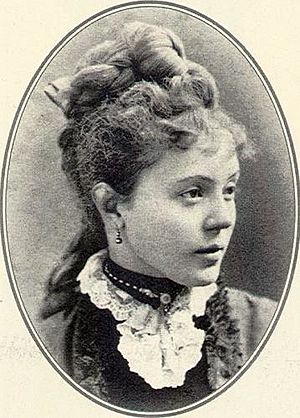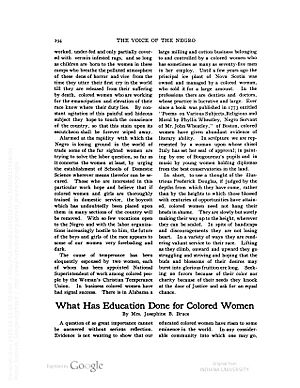Josephine Beall Willson Bruce facts for kids
Quick facts for kids
Josephine Beall Willson Bruce
|
|
|---|---|
 |
|
| Born |
Josephine Beall Willson
October 29, 1853 |
| Died | February 15, 1923 (aged 69) Kimball, West Virginia, U.S.
|
| Spouse(s) | Blanche Bruce |
| Children | Roscoe Conkling Bruce |
Josephine Beall Willson Bruce (October 29, 1853 – February 15, 1923) was an important activist for women's rights in the late 1800s and early 1900s. She spent most of her time working with the National Organization of Afro-American Women. She was a well-known person in Washington, D.C. for much of her life. There, she lived with her husband, Blanche Bruce, who was a United States Senator. Josephine Bruce was also the first black teacher in the public schools of Cleveland. Later, she became a respected educator at Tuskegee University in Alabama.
Contents
Early Life
Josephine Beall Willson was born in Philadelphia on October 29, 1853. Her parents were Dr. Joseph Willson and Elizabeth Harnett Willson. She was the first of their five children. Her family moved to Cleveland in 1854, when she was very young.
Her family believed education was very important. Josephine went to Cleveland Central High School and finished in 1871. After high school, she took classes to become a teacher. This led her to teach at the Mayflower School. This made her the first black teacher in Cleveland's public school system.
Personal Life
In 1878, Josephine married Blanche Bruce. They traveled around Europe together, learning about different cultures. When they came back to the United States, they settled in Washington, D.C.. Her husband started a career in politics, and Josephine became an activist.
In 1879, Josephine had her only child, Roscoe Conkling Bruce. He was named after Republican Senator Roscoe Conkling. Senator Conkling had helped Josephine's husband when he faced unfair treatment in Congress. Josephine waited to christen her son until they could go to Cleveland. She wanted the same minister who married her to christen her child.
Josephine Bruce dedicated her life to the National Organization of Afro-American Women (NACW). She successfully ran for vice president of the organization in 1896. In 1898, her husband, Blanche K. Bruce, passed away. Josephine then managed his money and land very well.
Booker T. Washington offered her a job as the principal at his Tuskegee University. She worked there from 1899 to 1902. She continued to support education and helped train other school teachers. This was a big change for her, moving from a busy city to a rural area.
Josephine's focus on education inspired her son, Roscoe Bruce. He graduated from Harvard University in 1902. He later became the head of the academic department at Tuskegee University. Josephine then lived in Mississippi for a short time with her family. She returned to Washington, D.C. to run for president of the NACW in 1906.
Josephine Bruce died in her sleep on February 15, 1923. She passed away in Kimball, West Virginia, after a heart attack.
Social Life
Josephine Bruce was a skilled hostess and a well-known person in society. This was especially true when her husband was a Senator. The African-American newspaper Washington Bee said she was very polite in her social visits. She was known for being fashionable and very beautiful.
However, Josephine and her husband faced challenges. Some people in the black community felt they spent too much time with white people. At the same time, many white people did not fully accept them. They were sometimes left out of social events not related to Blanche Bruce's Senate work. This was because of their race. After her husband's time in the Senate ended, this social rejection by white people happened more often.
Activism and Education
Because of racial divides, Josephine Bruce was often not allowed to join white women's rights groups. This led African-American women to form their own national organizations. These groups allowed Josephine to take on many leadership roles.
Josephine started her career as a teacher at Mayflower School in Cleveland. This made her the first black teacher in the city's public school system. Her teaching jobs at Mayflower School and Tuskegee University allowed her to share her ideas. She helped shape the minds of young people.
Outside of teaching, she worked hard for the National Organization of Afro-American Women (NACW). She became the vice president of the organization in 1896. She also helped inspire Mary Church Terrell, another important activist. Josephine invited Mary to stay with her in Washington.
Josephine also worked with black female teachers to strengthen the new National Association for the Advancement of Colored People (NAACP). She focused on how black women could help improve society. Bruce was also involved with the World Purity Federation and the Woman's Christian Temperance Union. She traveled widely with her husband when he gave speeches.
She became the editor of National Notes, a magazine owned by the NACW. In her writings, she talked about how important better education was for women of color. Josephine Bruce was a strong supporter of women's right to vote. Her goals matched those of the NACW.
Writings and Speeches
Josephine Bruce wrote several articles and gave speeches during her career. She often talked about education and activism. Some of her work appeared in The Voice of the Negro and The Crisis. One of her speeches was printed in the Philadelphia Times.
The Congress a Great Success
In 1879, two women's groups joined to form the National Association of Colored Women. Josephine gave a speech celebrating this union. She spoke about women's right to vote. She also celebrated the shared goals that brought African-American women together. Josephine said that voting rights would help women rise up and improve life for all African Americans. She believed it would also help change negative ideas about African Americans.
What Has Education Done for Colored Women
This article was published in 1904 in The Voice of the Negro. In it, Josephine Bruce argued that educating African-American women helped their families and communities grow stronger. She wrote that education allowed women to become more important in their communities. This let them give back and help improve society. Bruce believed that women, by working as teachers, church leaders, and temperance advocates, could make their communities better.
She gave examples of different African-American communities. She showed how education led to a better quality of life. She linked higher education levels to communities that had "exemplary lives." These educated people were able to improve their communities.
The Afterglow of the Women's Convention
In November 1904, Josephine wrote for The Voice of the Negro about the NACW's convention. She shared a story about meeting a young boy after a meeting. This made her realize the great things the women's organization was doing for children like him. She wrote that the future was built "at the foundation of the organization of women."
She said that the NACW was growing a lot. Its goal was to give "proper direction and purpose to the lives of the younger generation." Josephine emphasized that the NACW's goals were growing and making lasting changes. She noted that 36 states and one territory were members. Bruce concluded that the NACW had made great achievements. These marked a "new milestone in the progress of colored women." This brought them closer to gaining equal rights across the nation.
Colored Women's Clubs
This article was published in August 1915 in The Crisis. This was the official magazine of the National Association for the Advancement of Colored People. Mrs. B. K. Bruce, Josephine's married name, wrote about how the national club movement for women of color began. It started when Josephine St. Pierre Ruffin called for a meeting of women who supported voting rights.
Over the next few years, two national women's groups merged. They formed the National Association of Colored Women. Mrs. Bruce wrote about the organization's success. She called it a "social service not alone for colored people but for humanity." She noted that over four hundred delegates from across the country attended their conventions. Josephine ended by explaining that about one thousand clubs were part of the NACW. The money raised was used to create places like orphan homes and social centers.
Images for kids







